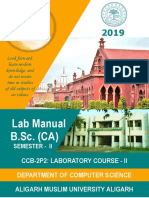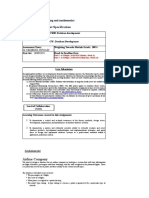CS331 System Software Lab CSE Syllabus-Semesters - 5
Uploaded by
RONIN TCS331 System Software Lab CSE Syllabus-Semesters - 5
Uploaded by
RONIN TB-Tech CSE S5& S6 Syllabus & Course Plan
Course No. L-T-P Credits Year of
Course Name
Introduction
CS331 SYSTEM SOFTWARE LAB 0-0-3-1 2015
Course Objectives
To build an understanding on design and implementation of different types of systemsoftware.
List of Exercises/Experiments: (Exercises/experiments marked with * are mandatory from
each part. Total 12 Exercises/experiments are mandatory)
Part A
1. Simulate the following non-preemptive CPU scheduling algorithms to find turnaround
time and waiting time.
a) FCFS b) SJF c) Round Robin (pre-emptive) d) Priority
2. Simulate the following file allocation strategies.
a) Sequential b) Indexed c) Linked
3. Implement the different paging techniques of memory management.
KTU STUDENTS
4. Simulate the following file organization techniques *
a) Single level directory b) Two level directory c) Hierarchical
5. Implement the banker’s algorithm for deadlock avoidance.*
6. Simulate the following disk scheduling algorithms. *
a) FCFS b)SCAN c) C-SCAN
7. Simulate the following page replacement algorithms
a) FIFOb)LRU c) LFU
8. Implement the producer-consumer problem using semaphores. *
9. Write a program to simulate the working of the dining philosopher’s problem.*
For more study materials>www.ktustudents.in
B-Tech CSE S5& S6 Syllabus & Course Plan
Part B
10. Implement the symbol table functions: create, insert, modify, search, and display.
11. Implement pass one of a two pass assembler. *
12. Implement pass two of a two pass assembler. *
13. Implement a single pass assembler. *
14. Implement a two pass macro processor *
15. Implement a single pass macro processor.
16. Implement an absolute loader.
17. Implement a relocating loader.
18. Implement pass one of a direct-linking loader.
19. Implement pass two of a direct-linking loader.
20. Implement a simple text editor with features like insertion / deletion of a character,
word, and sentence.
21. Implement a symbol table with suitable hashing.*
Expected Outcome
Student is able to
KTU STUDENTS
1. Compare and analyze CPU Scheduling Algorithms like FCFS, Round Robin, SJF, and
Priority.
2. Implement basic memory management schemes like paging.
3. Implement synchronization techniques using semaphores etc.
4. Implement banker’s algorithm for deadlock avoidance.
5. Implement memory management schemes and page replacement schemes and file allocation
and organization techniques.
6. Implement system software such as loaders, assemblers and macro processor.
For more study materials>www.ktustudents.in
You might also like
- Ktu Students: For More Study Materials WWW - Ktustudents.inNo ratings yetKtu Students: For More Study Materials WWW - Ktustudents.in2 pages
- Operating Systems Lab: Course Code: 19IT1105 L T P CNo ratings yetOperating Systems Lab: Course Code: 19IT1105 L T P C1 page
- Os and CD Lab Manual r20 Ai 2022-2023 Sem-1 (1) (1)No ratings yetOs and CD Lab Manual r20 Ai 2022-2023 Sem-1 (1) (1)112 pages
- IF-CO WebBasedApplicationDevelopmentWithPHP 141220181908 GAE3No ratings yetIF-CO WebBasedApplicationDevelopmentWithPHP 141220181908 GAE39 pages
- Micro Project: Shri H. H. J. B. Polytechnic100% (1)Micro Project: Shri H. H. J. B. Polytechnic12 pages
- IF - Cloud computingISchemeSixthSemester - 141220181811No ratings yetIF - Cloud computingISchemeSixthSemester - 1412201818119 pages
- CS303 System Software Syllabus-Semesters - 5No ratings yetCS303 System Software Syllabus-Semesters - 55 pages
- Lab Manual B.Sc. (CA) : Department of Computer Science Ccb-2P2: Laboratory Course - IiNo ratings yetLab Manual B.Sc. (CA) : Department of Computer Science Ccb-2P2: Laboratory Course - Ii31 pages
- Ashutosh Kumar 13000120129 CSE Software Engineering Lab ESC 591No ratings yetAshutosh Kumar 13000120129 CSE Software Engineering Lab ESC 591109 pages
- Ashutosh Kumar 13000120129 CSE Software Engineering Lab ESC 5910% (1)Ashutosh Kumar 13000120129 CSE Software Engineering Lab ESC 591109 pages
- FINAL BTECH DBMS 3RD SEM LAB MANUAL (1)No ratings yetFINAL BTECH DBMS 3RD SEM LAB MANUAL (1)63 pages
- FPT University Undergraduate Program Syllabus: (Under Decision No.1040/QĐ-ĐHFPT Dated 10/8/2018)No ratings yetFPT University Undergraduate Program Syllabus: (Under Decision No.1040/QĐ-ĐHFPT Dated 10/8/2018)18 pages
- 7CS082 Database Development CW 2022 SpecNo ratings yet7CS082 Database Development CW 2022 Spec8 pages
- C# Fundamentals Made Simple: A Practical Guide with ExamplesFrom EverandC# Fundamentals Made Simple: A Practical Guide with ExamplesNo ratings yet
- C# Algorithms for New Programmers: A Practical Guide with ExamplesFrom EverandC# Algorithms for New Programmers: A Practical Guide with ExamplesNo ratings yet
- C++ Basics for New Programmers: A Practical Guide with ExamplesFrom EverandC++ Basics for New Programmers: A Practical Guide with ExamplesNo ratings yet
- Blue Pelican Java Textbook by Charles E. CookNo ratings yetBlue Pelican Java Textbook by Charles E. Cook543 pages
- A Common Sense Guide to Data Structures and Algorithms in Python Volume 1 Level Up Your Core Programming Skills Jay Wengrow all chapter instant download100% (2)A Common Sense Guide to Data Structures and Algorithms in Python Volume 1 Level Up Your Core Programming Skills Jay Wengrow all chapter instant download77 pages
- IT Officer Questions & Answers: "Help Others Achieve Their Dreams and You Will Achieve Yours"No ratings yetIT Officer Questions & Answers: "Help Others Achieve Their Dreams and You Will Achieve Yours"136 pages
- Java Collection & Multithreading ProgramNo ratings yetJava Collection & Multithreading Program26 pages
- Unit - 11 Sets & Maps: 3140705 Object Oriented Programming - INo ratings yetUnit - 11 Sets & Maps: 3140705 Object Oriented Programming - I10 pages
- Array Interview Questions Data Structure Algorithms 1730130847No ratings yetArray Interview Questions Data Structure Algorithms 173013084736 pages
- Principles of Database Management Systems: 4.2: Hashing TechniquesNo ratings yetPrinciples of Database Management Systems: 4.2: Hashing Techniques36 pages
- Search, Insert and Delete in An Unsorted Array: SearchingNo ratings yetSearch, Insert and Delete in An Unsorted Array: Searching19 pages

























































































